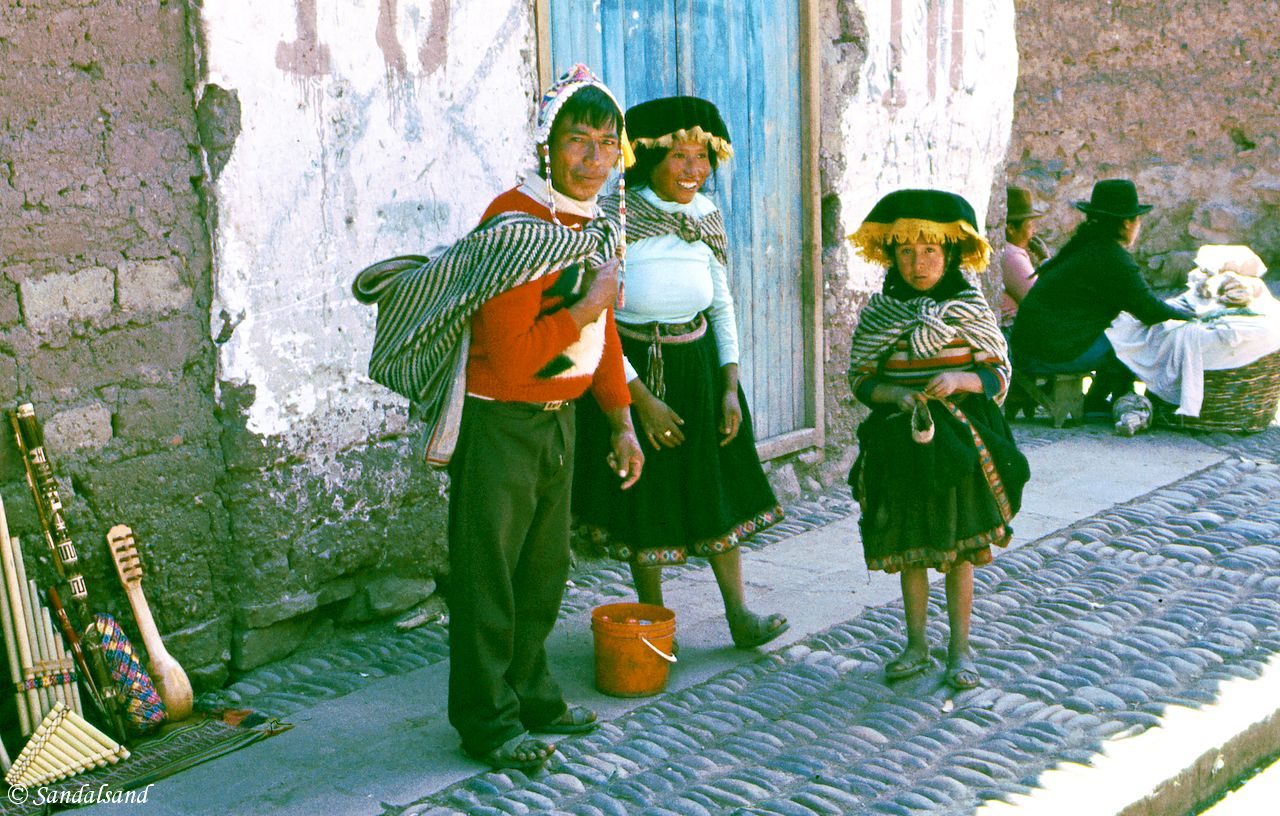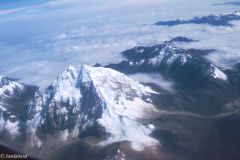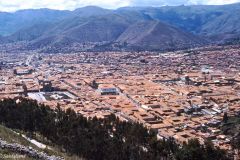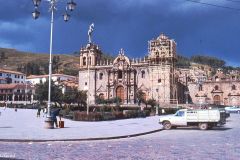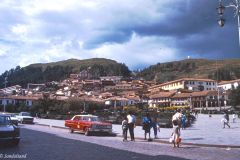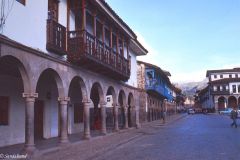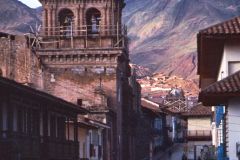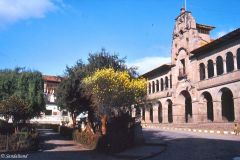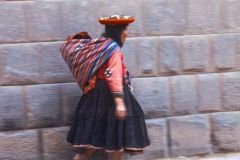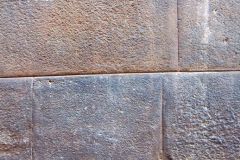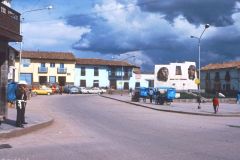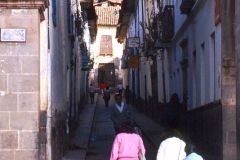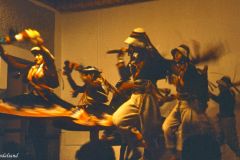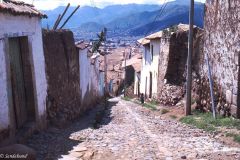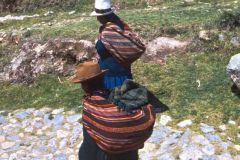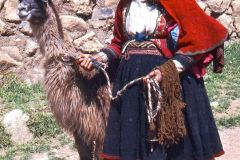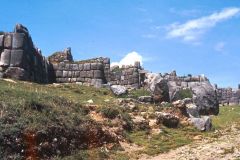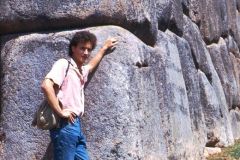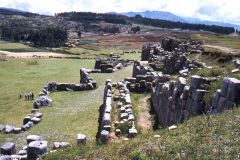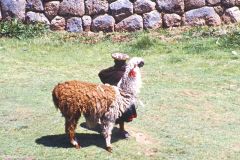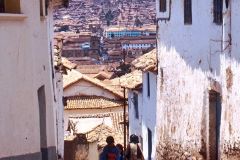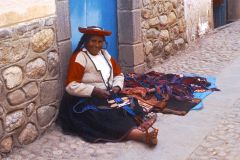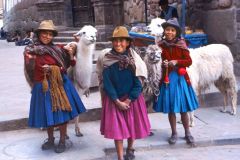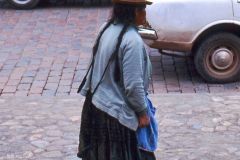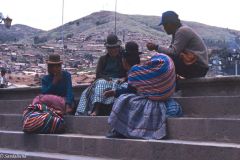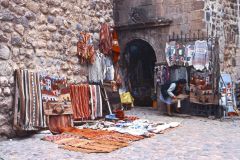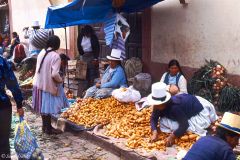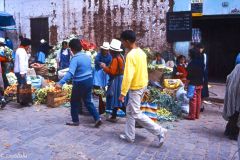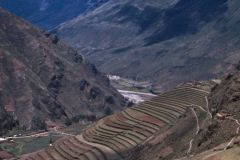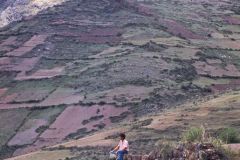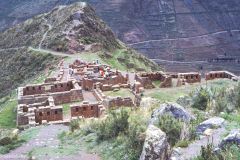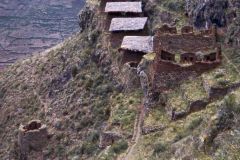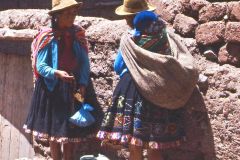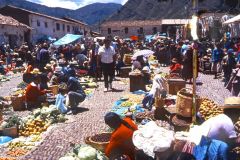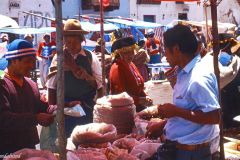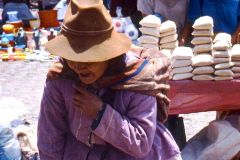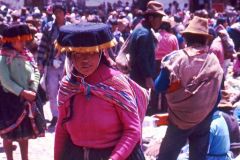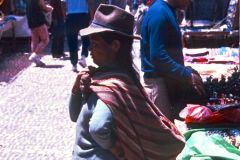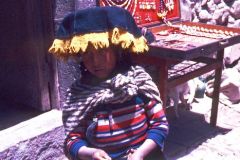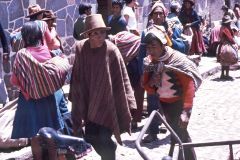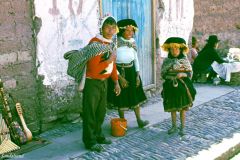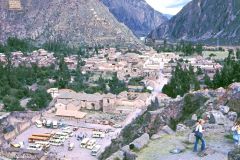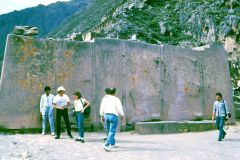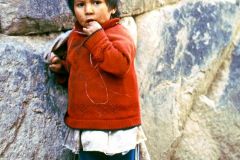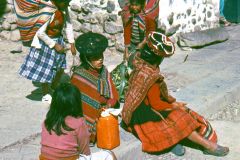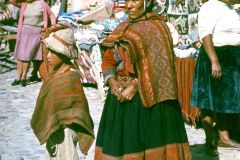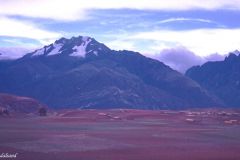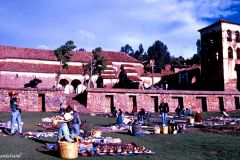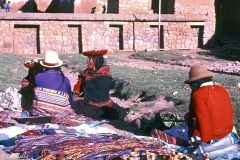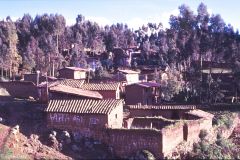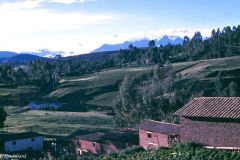Cuzco and other Inca towns was up next. Cuzco was the ancient capital of the once mighty Inca people, and was our first of several Inca towns in southern Peru. Christmas was near and we wanted to spend it in the mountainous south, away from Lima.
This article is part of a travelogue from of a five month journey in 1987-1988 to several countries in South America: Brazil, Peru, Ecuador, Bolivia, Chile.
Thursday 17.12.1987, Lima – Cuzco
Flying into Cuzco
It was a lovely day and all went well. In Lima we took an early morning taxi to the airport for only 150 intis (2 dollars). We didn’t hesitate long before checking in (unfortunately we didn’t find the Selva magazine in the kiosks) and we actually got very good seats on the plane. (A remark at the time of blogging (2012): In northern Peru we were appointed foreign correspondents for “La Selva” a regional magazine. Read about it here.)
The plane even departed on time and landed in Cuzco after an hour flight over snow-capped mountains lying as islands in a sea of clouds. It was beautiful. Unexpectedly we were served breakfast on the plane.
The baggage pickup went well and as a precaution we took a taxi into town for 60 intis (0.75 USD). The driver was pleasant, spoke a lot of Cuzco and offered us a tour of some ruins in the district for 10 USD or 600 intis. We thanked no for the time being.
We got out of the taxi on the Plaza de Armas after a fine ride from the airport. Cuzco has hardly any modern buildings; most of them are in old colonial style with red-brownish bricks. Really nice, and we soon found out we would like us here. The town is situated below hills or mountains on all sides apart from in the south – where a valley stretches downwards.
- El Peregrino Hotel. Walk up Calle Medio from the Plaza de Armas about 10 metres. At the end of a colonnade is a sign stating “Hospedaje”. Hit the call button. The rate is a bit stiff: 400 intis (5 dollars) for a twin bed room with bath. On the other hand it is nice and clean with hot water morning and evening, towels, toilet paper and soap. Nice staff. We were served coca-tea when we came. Website. Map.
First impressions
We relaxed for a couple of hours – a wise thing to do at an altitude of 3,400 metres. We then went out for lunch at a Hare Krishna restaurant for a few cents. It was good with a lot of spinach and no meat. The menu had much healthy food and tempting as well.
After lunch we walked around in a very exciting town centre and had close looks at the remains of the old Inca walls – perfectly cut stones.
This evening we paid a hundred intis (a dollar was worth about 85 intis) for a folklore show at the Inti Raymi Theatre with a photographic slide show, music and various dances. We drank pisco sour, the speciality here. It was all very good. The national costumes were lovely and it was fun to see that the dances here too are about making courtships, with the man as the active part.
There are a lot of tourists, mostly the backpacking type. Cuzco has many hotels and guest houses, and very many souvenir shops and sellers, neither particularly aggressive. There is an abundance of small and big restaurants. After the show we found one playing Santana – great.
We figure on staying here in Cuzco till after Christmas before continuing to Puno, Titicaca and Bolivia. We also suppose we’ll be doing some souvenir shopping. There are many fine things, both to myself, a Christmas present to my girlfriend Bo and to people at home.
Friday 18.12.1987, Cuzco
After breakfast we went to have a look at an Inca wall in a street behind the Cathedral. There was a twelve-sided stone, famous, but not more impressive than the others despite its twelve sides.
We then climbed up to the Inca fortress above the town, Saqsayhuaman, with impressive walls and with a large flat field where the Inca could watch his parading troops. There was a fine view of the town and llamas were being dragged around.
The Cathedral was mighty and contained a lot of treasures. We had to buy a combined entrance ticket to a number of sights in the region (150 intis, less than two dollars for students).
Saturday 19.12.1987, Cuzco
Shopping day
As Christmas is coming up fast we will have to go gift hunting. Luckily there’s only Bo to buy a present to this year. We split and I found an alright present to her after a little while.
Another object was despite a lot of necessary hard bargaining still not within economic range (400 intis = 5 dollars). It was a nice, large and colourful tablecloth. I therefore took Bo along later in the day to have a closer look and to discuss if we should buy it. We did. (Others had demanded the double and three times as much for a similar tablecloth.)
Down at, beyond, and even along the railway lines at the San Pedro station there was a huge market. They were selling general bric-a-brac and food for the crowding local population.
Later I bought six figurines for half a dollar, a nicely carved wooden ball for two dollars and a shoulder strap for my camera for 1.50.
Pickpockets here too
When Bo had moved alone towards the market by the railway station she had been made aware of a knife cut underneath the entire back of her bag. She had not noticed anything and the thief had no success. Her camera was at the front and only her jumper and a roll of toilet paper was at the back end sealing the values inside the bag. She reported the attempted theft to an accommodating policeman, just for the sake of public statistics.
This evening we went to a couple of music bars, peñas. Really nice. The Kamikaze was particularly good with an excellent band – folk music – and Western reggae and rock rhythms in the intervals.
Letter to my family
Cuzco, Peru, Saturday 19th of December 1987
Hello everyone,
We have now arrived in the stronghold and capital of the Incas, far up in the Peruvian Andes Mountains, at 3,400 metres above sea level. It’s been a couple of days since we arrived we’ll stay until Christmas Day (25.12). Then we will continue south to Lake Titicaca where Thor Heyerdahl was inspired to build his reed boats.
We will continue on to La Paz where we are looking forward to pick up Christmas mail and other things from you. Thanks for two letters from you (and one from A), picked up in Lima the 16.12. We stayed longer in Ecuador than expected, you see.
.
It is now more than a month since I last wrote to you. The reason is that we followed a two week hyper intensive Spanish course in Quito and had little spare time to experience other things. Afterwards we travelled around so fast that we haven’t had time. Now I have the necessary time and adventures enough to tell about.
It is wise to speak Spanish here in South America, as few people speak English. Therefore we threw in 1300 NOK (200 USD) for a private teacher each. They worked with us 7 hours a day for 10 days, in addition to giving us homework enough for 3 hours a day. We learned a good deal, and now look forward to practising our newly acquired knowledge. They were very hard studies.
In Quito we were able to take part in the week-long annual celebration of the establishment of the city. There were songs and music and food and vendors everywhere. Fun. We also joined a couple of parties arranged by our school and really enjoyed ourselves in this city.
.
I don’t recall mentioning it, but we went on a Sunday excursion to a mountain top above the city. 1000 metres hard and steep climb in this thin air (up to 3800 metres) made particularly the lungs work hard. But it was lovely later when we down here could look up on the top and say “been there”!
But then school was over and we could travel again. We were in kind of a hurry to get here before Christmas. On the way south we stopped in a few Ecuadorian towns in mountains. We visited a couple of Indian markets that were incredibly colourful and exciting. We passed by several mighty volcanoes and had from our hotel room in a town a view towards a majestic, snow-capped volcano 6300 metres high. (This hotel room was by the way a coup. We paid somewhat more than usual – 20 NOK ($3) each – for a double bed, wall-to-wall carpet, bath with hot water (a luxury) and towels and toilet paper and a view and nice and clean and everything (TV) – a sheer Hilton experience to us.
.
Ecuador was generally cheap. We paid on average only 40 NOK ($6) each a day, all inclusive.
The journey from the mountains of Ecuador (Riobamba) to Lima was almost taken in one piece. We first took a night bus down to the border. There we found out that we might as well go straight to Lima. Stress. The Peruvian bus company was supposed to be good, but we were given poor seats on a poor bus that broke down and we had to wait three hours to get it mended. Countless stops on the way (some apparently unexplainable and some police controls) made us arrive in Lima after 28 hours. There the baggage collection took its time and we were only able to find an expensive and lousy hotel room with zero hot shower. After two nights on a bus.
The scenery along Peru’s Pacific coast was heavily characterized by desert (sand and rock) with some green oases in between. There were truly no good living conditions the inhabitants of the small towns had. My thoughts moved inevitably to the desert in Syria.
The next day and the following day were both quite alright. We got ourselves a better hotel, swiftly bought an airplane ticket here to Cuzco, picked up letters from you in Norway and went about sightseeing.
There are impressive churches and buildings in Lima. We visited the building which housed the headquarters of the Inquisition in South America for some centuries. The methods and instruments of torture we read about and watched were truly gruesome: Deep dungeons, torture racks, the burning of foot soles dipped in oil, etc. etc. Next to the prisoner sat the priest with pen and paper ready to write down the “confession”.
.
We stayed in Lima only two days largely because of our personal safety. The city is almost worse than Rio when it comes to crime, and they say that there are schools for pickpockets. A method they are using is to stand in front of you with a spray can of paint and just like that start to spray all over you. While the unlucky tourist gets furious or confused, whatever, he gets robbed by another thief from behind.
The diversion manoeuvre is repeated in the toothpaste method. It consists of spraying the tourist with (green) toothpaste and a “nice, random” passer-by makes him aware of the mess. This person also offers to help drying it all off, alone or with a friend to follow up. And what happens when they get their fingers on the tourist’s body…?
I was twice subject to this trick, but I knew of the danger and nothing was stolen.
Cuzco has its criminals as well. When Bo today walked around alone in the city to buy a Christmas gift to me, she was made aware of a long knife cut along the entire back end of her bag. Nothing was lost, probably because her sweater was in the way for her camera in front of the bag.
.
As I have said before: You can never guard yourself 100 % against theft, but we’re doing what we can. I must add that physical abuse (armed robbery, assault) is fairly rare.
We took a plane to Cuzco, high over snow-capped mountain-ranges. The reason was not so much to spare time on a not too exciting or easily travelled stretch. Equally important to us was to avoid a special area – Ayacucho – which is so troubled with terrorist activities that even tourists should take care.
We hear all the time about murders on military, police, politicians and other officials. (Chile on the other hand, with its hard military dictatorship, is from what we hear calm. Not only are people afraid, and the secret police are everywhere, but the people are also less infested with unpleasant tourist thieves.)
In the end we arrived in Cuzco. It is a nice city with many tourists, hotels, souvenir shops and restaurants. There are many remains of Inca walls scattered around town – the rocks are incredibly well cut. There are many exciting things to buy as well, and we have done so. Tomorrow, Sunday, we will go on an excursion to several markets and villages in the area.
Tuesday we are off to Machu Picchu, the town in ruins that for centuries was hidden in the mountains undetected and undistorted by the Spaniards.
I’ll write more then. Now I’m hungry and need some dinner.
[This letter was continued on the 21st of December. See below]
Sunday 20.12.1987, Cuzco and its region
Pisac
This was to be a long day rich on content and impressions. We joined a tourist bus together with a Swiss couple. For 230 intis (2.7 USD) we made it to some ruins near Pisac, a market in the same town, and even more ruins and market square in Chincheros. We left at nine and returned at six in the afternoon.
It was beautiful scenery: Deep and wide valleys, high, partly snow-capped mountains and mountain plateaus followed us all the way.
The ruins in the hills above Pisac were divided into a series of places at times on very steep hillsides we had to cross: A lot of exciting buildings.
The Pisac market must be the most colourful we have seen so far, much because it is gathered on a rather small plaza.
Urubamba, Ollantaytambo and Chincheros
We had lunch in Urubamba before continuing to Ollantaytambo, a pleasant little town with narrow alleys and Inca ruins in good shape. In particular we found the stone lined terraces impressive.
The Chincheros market was small (we probably arrived a bit too late), but the town was interesting. The ruins in the town were on the other hand uninteresting. All the buildings were made of red-brownish, sundried stones of clay. The Indians were dressed in their traditional costumes, both the ones we saw on the market and elsewhere in the countryside.
There were tourists everywhere, unfortunately. They were coming in busloads upon busloads, transported from place to place, just like us.
Monday 21.12.1987, Cuzco
We are thinking of going to Machu Picchu tomorrow, the ruin town deep in the middle of nowhere that the Spanish never could find and destroy.
We went over to the San Pedro railway station shortly before their scheduled opening time (1000). There was already a 10 metre long queue outside. Despite this it took us two hours before we could walk out with the train tickets in our pockets.
The reason was primarily that the tour agencies have their employees out early buying tickets by the numbers. The ticket sellers have moreover not organised their work in a very efficient manner. There was only one counter and three persons. One of them was basically just standing there watching over the others, another person was performing the actual ticket sale, and the third was sitting on a desk stamping each ticket 10-15 times.
This takes time and as the office closed at 12 noon I felt sorry for the people behind us in line.
We notified the tourist office of the conditions.
Later on we bought ceramic figures to the family.
Letter to my family
Same place, Monday 21st of December 1987
The clock has just passed the midday hour and I have returned to my hotel room after buying tickets for Machu Picchu. We had to wait two hours before finally getting in front. The queue was actually only 10 metres, but it consisted of people from tour agencies who were paid to line up early, and they were buying tickets by the numbers. For that we others had to suffer. It is damned they can’t make another system and make things run more efficiently and with better service.
In any case, dear family, we are looking forward to spend two days among these unique ruins and surrounding areas.
.
You should have joined us yesterday. It was a fantastically exciting day. We took a minibus tour the entire day to the mountains, the plateaus and the little towns of the Cuzco region. Brilliant and mighty nature; poor but immensely colourful and photogenic Indians; small and medium sized houses of red clay; and market squares with lovely crafts and groceries in abundance.
We also visited some ancient Inca ruins, some of which were well preserved (partially restored) and carrying a sense of their glorious past. Time and again I’m struck by how perfectly cut the stones are, and how tight and firm the walls are. As far as I know, it is still a question how the craftsmen of the Inca king were able to do that without the aid of our contemporary electric cutting machines.
The use of land here in this country reminds me of some places in the Orient. As there are so many steep hillsides they have built terraces to plant on. And the hillsides where they go about digging the soil, by hand, are at times very steep.
[This letter was continued on the 24th of December. See next chapter]
Read more
The next chapter: Finally, one of the highlights of this South American journey was coming up. We were going to visit Machu Picchu. In addition we’re going to spend Christmas in a foreign land.
Read the introduction to this journey
View a full screen map of the journey
Click to view my entry about the City of Cuzco, the World Heritage Site
